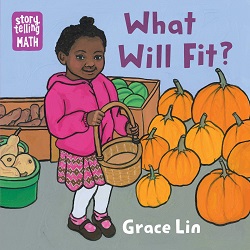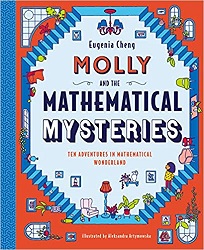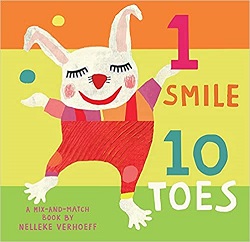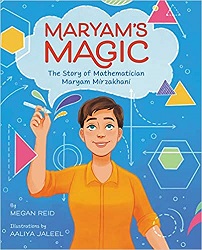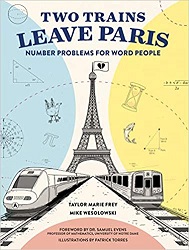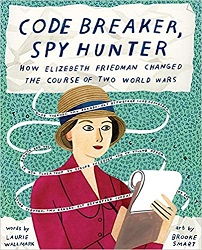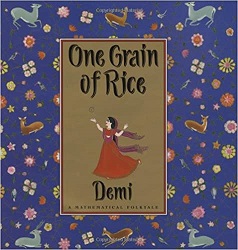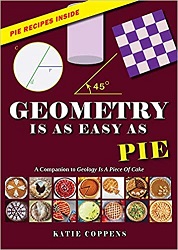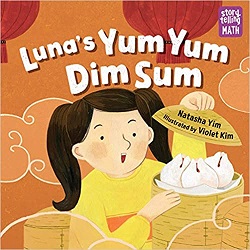I recently did a talk for a local group about math-related books I recommend for all age levels, and I made a long list of such books.
I decided to make this list a page on my website, because these weren’t the first people to ask me about this. And I’ll add to the list when I encounter more mathy titles that I love. I’ve already added a few after doing the talk.
Philosophy: Math at home should be nothing but FUN. Math in books should be nothing but FUN.
I look for exploring, discovery, and playfulness.
I haven’t reviewed all the books, but I’ll put a link to the review for those I have.
Earliest Learners
Goodnight, Numbers, by Danica McKellar
Crash! Boom! A Math Tale, by Robie H. Harris, illustrated by Chris Chatterton
Stack the Cats, by Susie Ghahremani
One Fox: A Counting Book Thriller, by Kate Read
Quack and Count, by Keith Baker
Early Numeracy
Counting
The Doorbell Rang, by Pat Hutchins
The Cookie Fiasco, by Dan Santat
How Many Jelly Beans? by Andrea Menotti, illustrated by Yancey Labat
8: An Animal Alphabet, by Elisha Cooper
Count the Monkeys, by Mac Barnett, illustrated by Kevin Cornell
Math Fables, by Greg Yang, illustrated by Heather Cahoon
100 Bugs! A Counting Book, by Kate Narita, pictures by Suzanne Kaufman
Monkey Time, by Michael Hall
Anno’s Counting Book, by Mitsumasa Anno
Anno’s Counting House, by Mitsumasa Anno
Comparing
Lia and Luís: Who Has More? by Ana Crespo, illustrated by Giiovan Medeiros
Balancing Act, by Ellen Stoll Walsh
Who Eats First? by Ae-hae Yoon, illustrated by Hae-won Yang
How Long Is a Whale? by Alison Limentani
How Much Does a Ladybug Weigh? by Alison Limentani
Critical Thinking
How Many? A Different Kind of Counting Book, by Christopher Danielson
Which Is Round? Which Is Bigger? by Mineko Mamada
Pattern Fish, by Trudy Harris, illustrated by Anne Canevari Green
Sam Sorts, by Marthe Jocelyn
I Know Numbers, by Taro Gomi
Bedtime Math, by Laura Overdeck
Bedtime Math: This Time It’s Personal, by Laura Overdeck
Bedtime Math: The Truth Comes Out, by Laura Overdeck
Young Elementary School Math
Counting/Estimation/Number Sense
Everybody Counts, by Kristin Roskifte
A Million Dots, by Andrew Clements, illustrated by Mike Reed
Great Estimations, by Bruce Goldstone
Greater Estimations, by Bruce Goldstone
Mapping and Measuring
Mapping Sam, by Joyce Hesselberth
Millions to Measure, by David M. Schwartz, pictures by Steven Kellogg
Addition and Subtraction
Mice Mischief: Math Facts in Action, by Caroline Stills, illustrated by Judith Rossell
Do Not Open This Math Book, by Danica McKellar
Multiplication and Division
The Best of Times, by Greg Tang
The Times Machine, by Danica McKellar
Fractions
Piece = Part = Portion: Fractions = Decimals = Percents, by Scott Gifford, photographs by Shmuel Thaler
Fractions in Disguise, by Edward Einhorn, illustrated by David Clark
Fraction Frenzy, by Rob Colson
More Math-Related Fun
Mysterious Patterns: Finding Fractals in Nature, by Sarah Campbell
I See a Pattern Here, by Bruce Goldstone
That’s a Possibility! by Bruce Goldstone
Infinity and Me, by Kate Hosford, illustrations by Gabi Swiatkowska
Seven Golden Rings: A Tale of Music and Math, by Rajani LaRocca, illustrated by Archana Sreenivasan
Math at the Art Museum, by Group Majoongmul, illustrated by Yun-ju Kim
Prime Numbers
You Can Count on Monsters, by Richard Evan Schwartz
Number Facts
A Hundred Billion Trillion Stars, by Seth Fishman, illustrated by Isabel Greenberg
Just a Second, by Steve Jenkins
It’s a Numbers Game! Basketball, by James Buckley, Jr.
If…, by David J. Smith, illustrated by Steve Adams
If America Were a Village, by David J. Smith, illustrated by Shelagh Armstrong
Just the Right Size: Why Big Animals Are Big and Little Animals Are Little, by Nicola Davies, illustrated by Neal Layton
Critical Thinking
Which One Doesn’t Belong? by Christopher Danielson
Cao Chong Weighs an Elephant, by Songju Ma Daemicke, illustrated by Christina Wald
Anno’s Magic Seeds, by Mitsumasa Anno
Anno’s Mysterious Multiplying Jar, by Mitsumasa Anno
How Many Guinea Pigs Can Fit on a Plane? by Laura Overdeck
If Dogs Were Dinosaurs, by David M. Schwartz, illustrated by James Warhola
Picture Book Biographies
The Boy Who Loved Math, by Deborah Heiligman
Nothing Stopped Sophie, by Cheryl Bardoe, illustrated by Barbara McClintock
The Boy Who Dreamed of Infinity, by Amy Alznauer, illustrated by Daniel Miyares
Hidden Figures, by Margot Lee Shetterly with Winifred Conkling, illustrated by Laura Freeman
Blockhead: The Life of Fibonacci, by Joseph D’Agnese, illustrated by John O’Brien
Upper Elementary/Middle School
What’s the Point of Math? by Ben Ffrancon Davis
Math Doesn’t Suck: How to Survive Middle School Math Without Losing Your Mind or Breaking a Nail, by Danica McKellar
Kiss My Math: Showing Pre-Algebra Who’s Boss, by Danica McKellar
Codes and Ciphers
Create Your Own Secret Language, by David J. Peterson
Can You Crack the Code? A Fascinating History of Ciphers and Cryptography, by Ella Schwartz
Code Cracking for Kids with 21 Codes and Ciphers, by Jean Daigneau
Building and Making
Calling All Minds, by Temple Grandin
Girls Who Build, by Katie Hughes
How to Be a Coder, by Kiki Prottsman
Critical Thinking
Really Big Numbers, by Richard Evan Schwartz
The Cat in Numberland, by Ivar Ekeland, illustrated by John O’Brien
Anno’s Hat Tricks, by Akihiro Nozaki and Mitsumasa Anno
Children’s Novels
The Phantom Tollbooth, by Norton Juster
The Number Devil: A Mathematical Adventure, by Hans Magnus Enzensberger
Secret Coders (Graphic Novel Series), by Gene Luen Yang and Mike Holmes
Numbed! by David Lubar
Biographies
Changing the Equation: 50+ US Black Women in STEM, by Tonya Bolden
Hidden Figures: Young Readers’ Edition, by Margot Lee Shetterly
High School Math
Hot X: Algebra Exposed, by Danica McKellar
Girls Get Curves: Geometry Takes Shape, by Danica McKellar
For Adults
Innumeracy: Mathematical Illiteracy and Its Consequences, by John Allen Paulos
How to Lie with Statistics, by Darrell Huff
Proofiness: The Dark Arts of Mathematical Deception, by Charles Seife
How to Bake Pi: An Edible Exploration of the Mathematics of Mathematics, by Eugenia Cheng
Here’s Looking at Euclid, by Alex Bellos
Freakonomics, by Steven D. Levitt and Stephen J. Dubner
The Numbers Behind Numb3rs: Solving Crime with Mathematics, by Keith Devlin and Gary Lorden
Humble Pi: When Math Goes Wrong in the Real World, by Matt Parker
How Charts Lie: Getting Smarter About Visual Information, by Alberto Cairo
How Not to Be Wrong: The Power of Mathematical Thinking, by Jordan Ellenberg
Stories of People
In Code, by Sarah Flannery, with David Flannery
Bringing Down the House, by Ben Mezrich
Busting Vegas, by Ben Mezrich
Hidden Figures, by Margot Lee Shetterly
Born on a Blue Day, by Daniel Tammet
Struck by Genius, by Jason Padgett
Count Down: Six Kids Vie for Glory at the World’s Toughest Math Competition, by Steve Olson
Novels
Beyond the Limit, by Joan Spicci
The Sand-Reckoner, by Gillian Bradshaw
Coloring Books
Patterns of the Universe, by Alex Bellos and Edmund Harriss
Visions of the Universe, by Alex Bellos and Edmunc Harriss
The Golden Ratio Coloring Book, by Steve Richards
Web Resources
Bedtime Math: bedtimemath.org
Mathical Book Prize: mathicalbooks.org
Math Book Magic: mathbookmagic.com
Talking Math With Your Kids: talkingmathwithkids.com
Mathematical Knitting: sonderbooks.com/sonderknitting
